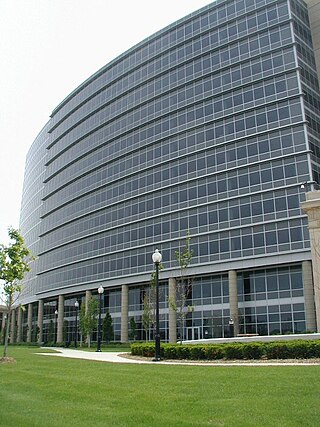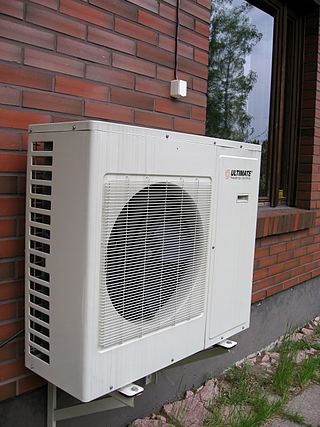Related Research Articles

A public utility company is an organization that maintains the infrastructure for a public service. Public utilities are subject to forms of public control and regulation ranging from local community-based groups to statewide government monopolies.
A utility cooperative is a type of cooperative that is tasked with the delivery of a public utility such as electricity, water or telecommunications to its members. Profits are either reinvested for infrastructure or distributed to members in the form of "patronage" or "capital credits", which are dividends paid on a member's investment in the cooperative.

The State Corporation Commission, or SCC, is a Virginia (USA) regulatory agency whose authority encompasses utilities, insurance, state-chartered financial institutions, securities, retail franchising, and railroads. It is the state's central filing office for corporations, limited partnerships, limited liability companies and Uniform Commercial Code liens.

CMS Energy, based in Jackson, Michigan, is an energy company that is focused principally on utility operations in Michigan. Its principal business is Consumers Energy, a public utility that provides electricity and natural gas to more than 6 million of Michigan's 10 million residents. Its non-utility businesses are focused primarily on domestic independent power production. Consumers Energy has operated since 1886.

Negawatt power is investment to reduce electricity consumption rather than investing to increase supply capacity. In this way investing in negawatts can be considered as an alternative to a new power station and the costs and environmental concerns can be compared.

The energy policy of the United States is determined by federal, state, and local entities. It addresses issues of energy production, distribution, consumption, and modes of use, such as building codes, mileage standards, and commuting policies. Energy policy may be addressed via legislation, regulation, court decisions, public participation, and other techniques.
Nova Scotia Power Inc. is a vertically integrated electric utility in Nova Scotia, Canada. It is privately owned by Emera and regulated by the provincial government via the Nova Scotia Utility and Review Board (NSUARB). Nova Scotia Power Inc provides electricity to 520,000 residential, commercial and industrial customers in Nova Scotia.
The Florida Public Service Commission (FPSC) regulates investor-owned electric, natural gas, and water and wastewater utilities. The FPSC facilitates competitive markets in the telecommunications industry, has authority over intercarrier disputes, and oversees pay telephones, the federal Lifeline Assistance Program and Telecommunications Relay Service.
The New York State Energy Research and Development Authority (NYSERDA), established in 1975, is a New York State public-benefit corporation, located in Albany, New York, with regional offices in New York City, Buffalo, and West Valley.

Community Choice Aggregation (CCA), also known as Community Choice Energy, municipal aggregation, governmental aggregation, electricity aggregation, and community aggregation, is an alternative to the investor-owned utility energy supply system in which local entities in the United States aggregate the buying power of individual customers within a defined jurisdiction in order to secure alternative energy supply contracts. The CCA chooses the power generation source on behalf of the consumers.

Vermont Energy Investment Corporation or VEIC is a non-profit organization in Chittenden County, Vermont that seeks to reduce the economic and environmental costs of energy consumption through energy efficiency and renewable energy adoption. Since its founding in 1986, the organization has been involved in designing energy efficiency and renewable energy programs in North America and worldwide.
There is a large array of stakeholders that provide services through electricity generation, transmission, distribution and marketing for industrial, commercial, public and residential customers in the United States. It also includes many public institutions that regulate the sector. In 1996, there were 3,195 electric utilities in the United States, of which fewer than 1,000 were engaged in power generation. This leaves a large number of mostly smaller utilities engaged only in power distribution. There were also 65 power marketers. Of all utilities, 2,020 were publicly owned, 932 were rural electric cooperatives, and 243 were investor-owned utilities. The electricity transmission network is controlled by Independent System Operators or Regional Transmission Organizations, which are not-for-profit organizations that are obliged to provide indiscriminate access to various suppliers to promote competition.

A community solar project, farm or garden is a solar power installation that accepts capital from and provides output credit and tax benefits to multiple customers, including individuals, businesses, nonprofits, and other investors. Participants typically invest in or subscribe to a certain kW capacity or kWh generation of remote electrical production. The project's power output is credited to investors or subscribers in proportion to their investment, with adjustments to reflect ongoing changes in capacity, technology, costs and electricity rates. Community solar provides direct access to the renewable energy to customers who cannot install it themselves. Companies, cooperatives, governments or non-profits operate the systems.
Energy Trust of Oregon is an independent nonprofit organization based in Portland, Oregon, United States. Energy Trust offers services, cash incentives, and other stuff to customers of Portland General Electric, Pacific Power, NW Natural, Cascade Natural Gas, and Avista in Oregon and customers of NW Natural in Washington.
The United States state of Arkansas is a significant producer of natural gas and a minor producer of petroleum.
Net metering in New Mexico is a set of state public policies that govern the relationship between solar customers and electric utility companies.
New York’s Reforming the Energy Vision (REV) is a set of multi-year regulatory proceedings and policy initiatives launched in New York state in 2014. REV is intended to transform the way electricity is produced, bought and sold in New York and enable the integration of renewable energy generation and smart grid technologies on the electric grid. REV is ongoing with no predefined end date, and will impact all New York utilities and ratepayers.

Delaware Electric Cooperative (DEC) is a not-for-profit electric utility based in Greenwood, DE. Delaware Electric Cooperative is a member-owned electric utility powering more than 300,000 people in Kent and Sussex Counties. DEC is a Touchstone Energy Cooperative and a member of Old Dominion Electric Cooperative, an electric generation and transmission cooperative. Through the hard work and committed efforts of its workforce, DEC has – and will continue – to “keep the lights on!”

Home energy upgrades from public utilities are added home energy efficiency and renewable energy features planned or installed by public utilities. Help from a public utility can make it easier for a homeowner to select, install or operate climate-friendly components. The utility might assist with coordinated use of utility-supplied energy, building features, financing, operating options and neighborhood supplied energy.
References
- ↑ "Focus on Energy Website". Archived from the original on 2009-08-05. Retrieved 2009-09-08.
- ↑ State of Wisconsin: Office of the Governor [ permanent dead link ]
- ↑ Wisconsin Legislative Council Information Memorandum, 2005 Wisconsin Act 141:Energy Efficiency, Renewable Resources, and Energy Policy